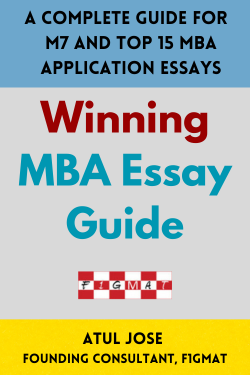In this ‘how to write MBA application essay’ series for Columbia MBA, I cover the PPIL Essay:
- History of PPIL
- Columbia Business School – Value Statement
- DEI at Columbia Business School
- Five Principles of Diversity, Equity, and Inclusion (DEI)
- 1. Creating an Inclusive Environment
- 2. Mitigating Bias and Prejudice
- 2. a Bias vs. Prejudice
- 3. Managing Intercultural Dialogue
- 4. Addressing Systemic Inequity
- 5. Understanding Identity and Perspective-Taking
History
The Phillips Pathway for Inclusive Leadership (PPIL) is named after Katherine Williams Phillips, who passed away on January 15th, 2020, after battling breast cancer. She was the Rueben Mark Professor of Organizational Character at Columbia Business School. Her leadership at the Sanford C. Bernstein & Co. Center for Leadership and Ethics was preceded by specializations and several studies on Diversity and its influence on productivity in groups, teams, organizations, and cultures.
Columbia Business School – Value Statement
In 2019-20, the school’s Diversity, Equity, and Inclusion Standing Committee crafted the value statement for Columbia Business School (short version):
“To achieve our vision of developing innovative ideas and inspiring leaders that transform the world, the members of CBS strive to build and sustain a welcoming and intellectual community that values and respects individuals’ different and shared identities and perspectives.”
Diversity, Equity, and Inclusion (DEI)
The Phillips Pathway for Inclusive Leadership (PPIL) is an extension of larger DEI initiatives at Columbia University that the school has undertaken with three action items - Build a Diverse Community, Curriculum and Classroom Inclusion, and create an Inclusive Culture.
Columbia MBA PPIL Essay Question: The Phillips Pathway for Inclusive Leadership (PPIL) is a co-curricular program designed to provide students with the skills and strategies needed to develop as inclusive leaders. Through various resources and programming, students explore and reflect on the following five inclusive leadership skills: Mitigating Bias and Prejudice, Managing Intercultural Dialogue, Addressing Systemic Inequity, Understanding Identity and Perspective-taking, and Creating an Inclusive Environment.
Describe a time or situation when you had the need to utilize one of these five skills and tell us the actions you took and the outcome. (250 words)
Alternatively, please share a specific example of how you made the team more collaborative or fostered a greater sense of community within an organization (The alternative prompt is available only for the August entering class)
With the essay, the admissions team wants to shortlist ethical leaders who have worked in keeping the five essential principles of DEI while solving problems for their employer, non-profit initiatives, or their community.
Five Principles of Diversity, Equity, and Inclusion (DEI)
1. Creating an Inclusive Environment
A common narrative I have heard in creating an inclusive environment is onboarding team members who are atypical for the industry or function. It could be women on-field engineers in the Oil & Gas industry, black workers who are stuck in frontline jobs without any training or career planning to reach a managerial role, the rural-urban divide with the cultural & language barriers as roadblocks for growth, or professionals from low-income households who don’t have the resources to retrain and lacks support – financial and network, to change geography for better opportunities.
While mentioning how you created an inclusive environment, spend most of your narrative on the challenges from a power dynamics perspective and the culture. It should not sound like you turned on a switch, and everything was fixed. Clearly articulate the roadblocks, how you negotiated, and the challenges of achieving milestones for the beneficiary.
Read Related Sample Essays
Sample Columbia PPIL Essay 2: Changing Biases in the Algorithm (244 Words)
2.Mitigating Bias and Prejudice
Katherine Phillips – the professor on which the inclusion initiative has been named, gave an excellent talk on Why Diversity Matters (Talks@Columbia). She captures the tone and tenure that you should try to emulate in your essay as well.
2.a. Bias vs. Prejudice
For prejudice, the best definition comes from the social psychologist Gustav Ichheiser (1970), who shares how instead of seeing someone who has a vastly different way of seeing the world as the effects of culture and psychological differences expected in individuals, prejudiced individuals see these differences arising from intellectual or moral defects. By consciously or subconsciously categorizing the ‘other’ person as inferior is the root of all prejudiced behaviors and thinking.
Writing Columbia MBA PPIL Essay about Bias Or Prejudice
3.Managing Intercultural Dialogue
A reason why political, religious, and cultural divide exists in campuses, society, and countries is the lack of will or openness to communicate across identities and cultures, fearing confrontation or re-examining one’s own belief system could lead to loss of power.
No one wants to be wrong publicly or lose status and eventually power among their echo chambers.
Intercultural dialogue (ICD) starts with the assumption that the concerned groups/team are openminded to prefer dialogues over isolation or violence.
Multiculturalism has been criticized for its isolationist tendencies, where communities from different cultures exist in siloes, rarely exchanging beliefs and ideas and eventually transferring cultural identities with each other.
The controversy of cultural appropriation is an extreme reaction to what an ideal society should be doing – exchanging ideas, customs, attires, food, and even beliefs with each other. Of course, with the sensitivity on ‘where,’ these unique cultural artifacts should be displayed (attire). A funeral dress in a culture reinvented into a party dress will be disrespectful despite all the good intentions.
ICD is a framework that depends on your patience and open-mindedness to create opportunities for diverse participants in a team to express their concerns, thoughts, or viewpoints. These ideas might not align with your values. However, by adhering to mutual respect, empathy, and open-mindedness to change one’s own perspective, your journey to understand a person from a different culture through dialogue could turn into an interesting narrative for the essay.
Capturing this journey is the toughest, as even changing a culture works in a space where the participants are open to new ideas. Unlike business schools where such groups are carefully chosen, in real life, you won’t find such cohesive teams.
I read a narrative on changing the culture in an Investment Bank. The change the applicant was trying to bring was so marginal that it felt silly to read the hardship narrative. Always seek external review (outside your industry and family) and come out of your echo chamber to validate that the narrative is not trivial. Reach out to me for the Essay Review Service.
4. Addressing Systemic Inequity
Systemic inequity that is propagated due to old ways of doing business, communicating, or the shared assumptions of a society that stems from unconscious biases are all good examples for the narrative.
One example that stood out was when a client was developing an algorithm for the recruitment process for a leading HR solutions provider. With biases existing in recruiting women candidates in the 26-30 age group as they are likely to start a family and cost the company in recruitment costs, a secret filter was enabled that downgraded CVs from this demographic.
The client was able to articulate the value of hiring women candidates from this demographic by highlighting a study that showed that in terms of productivity and impact, the revenue added 10x times the cost it takes to train a 22-25-year-old women candidate or recruit a replacement from the same demographic.
The narrative was believable because he didn’t preach or go on a rant about systemic biases. He understood the culture of the organization and recognized that data was ‘God.’ If he could present the case supported by credible data, management was likely to take corrective steps. And they did.
When you bring any systemic inequality narrative, choose only those examples where you could bring some change to the system.
5. Understanding Identity and Perspective-Taking
If you are in a position of power or influence or negotiating for a deal, difficult conversations are part of the job.
In neuroscience, there are two categories of perspective-taking – cognitive and affective.
Cognitive Perspective taking relies on your ability to interpret a person’s thoughts or beliefs.
Affective Perspective-taking relies on your ability to interpret a person’s feelings or emotions at that time.
Thoughts expressed by a person when remained unchallenged from lack of diverse viewpoints in your team or from power dynamics that limits questioning the status quo accumulates into a belief.
Emotions, when interpreted with a story, turn into feelings.
Interpreting another person’s belief or feeling could go wrong from lack of shared identities, lack of emotional intelligence, limited exposure to diverse cultures, and limited exposure to diverse perspectives.
Perspective Taking in Columbia MBA Essay is often around affective perspective taking and talking about the beneficiary’s feelings as it is easier to turn them into a narrative.
Atul Jose's Notes as an MBA Essay Reviewer
I remember reading an essay where the person shared an anecdote of being a sounding board to a colleague who was going through a divorce. She was quiet and ‘down’ in mood. Recognizing the emotion is a classic EQ trait or part of the affective perspective taking – to understand the feelings of that person and feel similar emotions (emotional contagion). The essay worked brilliantly to showcase the person’s EQ.
Now imagine an essay where by the end of the narrative, a conservative applicant becomes a liberal; a liberal applicant becomes a conservative or a centrist.
Which one would you think is a believable narrative?
Read Related Sample Essay: Recommending Social Media Controls (Liberal Applicant with Conservative peers) (247 Words)
The only essay I have read till now where the applicant attempted to create a bridge to a community that was unlike his world of liberal peers was a narrative around educating a community of religious students.
The beneficiaries were all from strict orthodox religious families.
Sin and hierarchy were so ingrained in the psyche that creative thinking that questions such established rules on communicating and thinking was considered a heresy.
Science on evolution was not even part of the curriculum.
Under such hostile beliefs towards science, teaching science was not just a non-profit experience but an experience of Cognitive perspective taking and recognizing that the students come from a different world.
The openness of the applicant and the empathy he showed while teaching the students were inspiring.
I kept reading to understand the techniques and tools he deployed to communicate such ‘belief’ shattering worldviews.
Understanding the identity of the students was essential to communicate with empathy.
Demonstrating empathy is the goal behind such narratives. Moderate the words and phrases that you use to narrate the out group. Talk from their perspective to reason why such beliefs exist.
Read Columbia MBA PPIL Essay Examples with F1GMAT’s Columbia MBA Essay Guide
References
- Identity, Belief, and Bias - Geoffrey L. Cohen, Stanford University
- Measuring Intercultural Dialogue - A conceptual and technical framework, Institute for Economics & Peace
- White Paper on Intercultural Dialogue, “Living Together As Equals in Dignity” Launched by the Council of Europe Ministers of Foreign Affairs at their 118 Ministerial Session (Strasbourg, 7 May 2008)
 I will teach you how to bring your life stories to essays faster with F1GMAT's essay guides. Download below or subscribe to F1GMAT's Service and work with me - Atul Jose, Author/Editor/Founding Consultant, F1GMAT(16 Years of helping applicants gain admissions to M7 and Top 30 schools)
I will teach you how to bring your life stories to essays faster with F1GMAT's essay guides. Download below or subscribe to F1GMAT's Service and work with me - Atul Jose, Author/Editor/Founding Consultant, F1GMAT(16 Years of helping applicants gain admissions to M7 and Top 30 schools) 